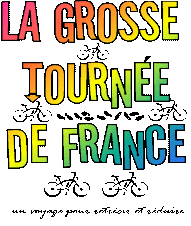Tours—the sequel - June 18-19
The next day I took a whirlwind tour of 5 chateaux: Azay-le-Rideau, Villandry, Clos-Luce, Amboise, and Chenonceau. The tour was divided into 2 parts (morning and afternoon) and consisted of 6 or 7 tourists (Canadian, Australian, British, Russian, Columbian, and of course American) in a yellow minivan with a chauffeur. He would drive us right up to the entrance, then come with us to buy the tickets to make sure that we got our group discount. We left @ 9:30am and arrived first at Azay-le-Rideau. Azay-le-Rideau is built right in the middle of a lake. It was built in 1515 by Gilles Berthelot, a former Treasurer of France, though he was soon accused of corruption and fled the country leaving his wife alone with an unfinished chateau. After that the chateau changed hands several times before finally becoming property of the state in 1905. Inside the chateau was an exhibit dedicated to the mythological tale of Psyche and Cupid.
The next chateau was Villandry. Built in 1536 by Jean le Breton, Finance Minister to Francois Ier, (who also supervised the construction of Chambord), Villandry is most known for its gardens. In fact, most people choose only to see the gardens, like me. The gardens are amazing geometric and architectural masterpieces. There are ornamental gardens, water gardens, herb gardens, vegetable gardens, a sun garden, woods, and a labyrinth. After seeing all of the gardens, it was nice to just sit on a bench and relax in the peace of the gardens. After a short lunch break (a sandwich in the Tours train station) we continued to Clos-Luce, where Leonardo da Vinci spent the last 3 years of his life. In 1516 at the age of 64, Leonardo was invited to join the French court at Amboise. He was given Cos-Luce and a salary of 700 gold crowns. He spent his time there painting, drawing, designing, and teaching. The chateau is filled with DaVinci’s thoughts and quotes, art and designs, machines and inventions.
Outside are gardens and studios where school children can come to learn about art, dance, and design. There were at least 150 kids there that day (which made it a little difficult to take pictures.
From there we went to Amboise, where Leonardo was buried in the chateau’s chapel in 1519. It was also the location of the first Order of French Knights, l’Ordre de St Michel, in 1469. The chateau is architecturally incredible and still has impeccably preserved period furniture (and some replicas, I’m sure). It was beautiful...check out the pictures.
The last chateau was Chenonceau, which was the most impressive chateau of the day. It was home to kings like Francois I and Louis XIV and queens like Diane de Poitiers and Catherine de Medici. Chenonceau is actually built across a river. The part of the chateau that stretches across the river is a grand ball room on the first floor and a museum on the second floor. The rest of the chateau served as the family’s residence, including the black bedroom on the 3rd floor where Louise of Lorraine retreated after her husband Henri III was assassinated. Always dressed in white, the protocol for royal mourning, she surrounded herself by nuns and spent her days in prayer and meditation. She earned the nickname “the White Queen.”
After the last chateau, the driver brought us to a CAVE (wine cellar/producer) for a wine tasting. It was an actual cave dug into the side of the mountain, though impeccably designed inside. We first took a tour of the lower caves were they stored the wine for aging. Then we tasted 3 different wines produced there. They were very good.
Finally, we returned to the train station about 7pm and I walked back to the hostel, eager to dine on the rest of my vegetables. They were almost as good as the wine. But, that wasn’t the end of the night…..
Subscribe to:
Post Comments (Atom)




No comments:
Post a Comment